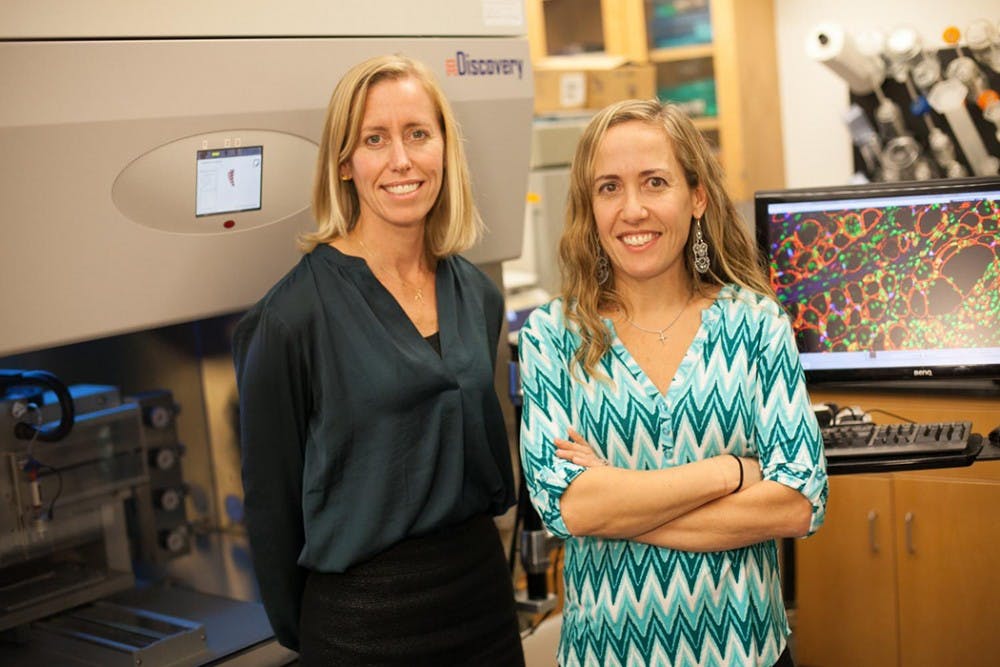Profs. Silvia Blemker and Shayn Peirce-Cottler in the Department of Biomedical Engineering received a $2.5 million grant from the National Institutes of Health. The grant will fund research on therapeutic outcomes for individuals with Duchenne Muscular Dystrophy through multi-scale computer modeling techniques.
DMD is a devastating — but rare — musculoskeletal genetic disorder, prevailing at a rate of one in every 3,500 male births. Individuals with DMD appear healthy for the first few years of their lives, Blemker said. However, around the age of three or four, symptoms begin to appear. Patients with DMD typically die around their early thirties.
First, the muscles of the hip, pelvic area, thighs and shoulders become fatigued, and then skeletal muscles of the arms and legs begin to deteriorate. In even later stages, the disease affects heart and respiratory muscles — impeding normal cardiovascular and breathing functions.
DMD is caused by a mutation in the gene encoding dystrophin. Dystrophin is a large protein that supports muscle fiber strength and connects the cytoskeleton of a muscle fiber to the surrounding extracellular matrix and links actin filaments to other support proteins.
In patients with DMD, even minor injuries damage and fatigue their muscles. As a result, patients with DMD become wheelchair-bound soon after they start walking.
“The muscles are getting weaker and degrading,” Blemker said. “They are getting damaged every time they are contracting.”
In the past, treatment of muscular dystrophy focused on a combination of orthopaedic and neurosurgical intervention and aggressive physical therapy.
“We used to spend a lot of time releasing contractures of the ankles and knees,” pediatric orthopaedic surgeon Dr. Mark Abel said.
However, surgical intervention is now reserved for select and rare cases, since it does not improve muscle strength in these patients.
Current treatment options target the symptoms of the disease, rather than the cause. For instance, doctors prescribe steroids such as prednisone to slow muscle damage and to reduce the age of onset for scoliosis.
Other steroids can also help to alleviate heart and lung problems associated with the disease. These treatments improve the life expectancy for these patients such that they can now live into their mid-twenties and thirties. Previously, these patients might not have made it to their thirties.
However, new treatments that target the root cause of DMD may be arriving soon.
Blemker and Peirce-Cottler first collaborated in examining cerebral palsy, using computer models to predict how different surgical approaches might lead to improved prognoses.
“Those first studies helped to establish the framework that allowed us to pivot to the lower limb and to think about DMD,” Peirce-Cottler said.
Peirce-Cottler and Blemker intend to use these computer-based models to investigate DMD and potential treatment options.
While the models derived from Peirce-Cottler's lab focus on biochemistry, or the environment of the cells including their proteins and signaling, Blemker deals with more mechanics.
Using these models, Blemker and Peirce-Cottlersaid they hope to find out why certain drugs for DMD have worked on animals but not in clinical trials. The researchers will also investigate the role inflammation and the immune system play in muscle damage and work on methods to diagnose DMD.
According to Peirce-Cottler, this computer-based approach could be expanded to potentially provide therapeutic outcomes for other neuromuscular and skeletal diseases. However, the main purpose of the NIH-funded project is to make a difference in DMD.
“I think bringing the two models together is the innovative part of our research … we aren’t just doing one modeling approach, but we are doing two modeling approaches that have never been married at all,” Peirce-Cottler said.
The advent of these new treatment options may reduce stress and depression for both DMD patients and their families. Today, a diagnosis of muscular dystrophy is extremely taxing on families, as there is no cure for the disease — leaving these children to be dependent on their families for their lives.
“Usually the first time the parent finds out about it, it is the first child — the first boy,” Abel said. “Then, they are told that they have a condition which is going to lead to degenerative condition that will lead to child’s inability to walk, make them wheelchair dependent and ultimately go on a ventilator and die, and that there is no cure for it.”
Many DMD children also become depressed because of their immobility and this can lead to being socially withdrawn.
However, many families persevere through outlets in their communities such as their church. Many also engage in non-profits that strive to improve outcomes for children with DMD.
“If you are not involved in one of these organizations that seek a cure, it can be a very hopeless life for you and your child,” Abel said.
Families also become involved in multidisciplinary centers that focus on DMD. At the medical center, Dr. Rebecca Scharf, a pediatrician, helps to run a neuromuscular clinic with different specialities providing comprehensive care for muscular dystrophy patients. Through this experience at the clinic, Scharf has been inspired by both patients and their parents.
“Over and over I see children living with medical challenges in ways that are gifts to others. I see families supporting one another,” Scharf said. “I see children making a difference in their preschool classrooms and teaching others about children living with disabilities.”
The clinic also serves as a place for support where physicians, parents and patients are constantly interacting and learning from one another.
“Our patients have taught me about perseverance and hope while they are experiencing significant challenges,” Scharf said.







